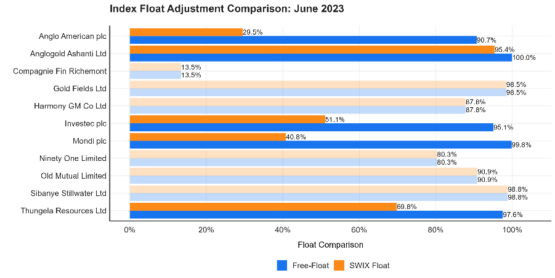The idea of harmonising the FTSE/JSE Shareholder Weighted Index (Swix) and All Share Index (Alsi) has been a prominent topic of discussion for years and is finally set to take place in March 2024.
We see this as a major positive shift as this alignment – or “index harmonisation” – will bring numerous benefits to the asset management industry.
ADVERTISEMENT
CONTINUE READING BELOW
The what: Uniting benchmarks for a cohesive future
The Johannesburg Stock Exchange (JSE) has actively engaged the financial community to navigate this shift toward a single, representative benchmark index.
Over time, the indices have naturally come into alignment, making harmonisation more feasible. Notably, the differences between Swix and Also have dwindled, paving the way for this pivotal transition.
Read: Culling the index herd on the JSE
For the remainder, we will focus solely on the Swix, and not the Capped Swix, given they are currently virtually equivalent following Naspers’s reduced index weight.
The why: Aligning interests for a level playing field
Both the Swix and Alsi methodologies encompass the same constituent companies but vary in how they consider the “free floats” for certain businesses. This divergence primarily arises from companies that shifted their primary listings offshore before October 2011 (known as grandfathered companies), considered at their full global float for Alsi weight calculation1.
The Swix methodology, introduced in 2004, was designed to consider only the locally available float on STRATE, thereby down-weighting these grandfathered companies. But corporate actions in recent quarters have significantly narrowed the float differences, particularly for companies like Richemont (CFR), BHP Group (BHG), South African Breweries (SAB), Old Mutual (OML), Harmony Gold (HAR), and Gold Fields (GFI), among others.
Read:
What the shrinking JSE means for retirement funds
Gold Fields eyes Chile expansion as new $1bn mine starts up
AngloGold will pay Sars R4.5bn to walk away from SA
End of an era … AngloGold Ashanti moves primary listing to New York
The process of index harmonisation is now less disruptive, given this convergence in float differences. Notable distinctions between the two methodologies presently pertain to Anglo American (AGL), Investec Plc (INP), and Mondi (MNP), with the underweights offsetting the few remaining grandfathered over-weights.

1Index weights are determined by multiplying shares in issue (SSI) with price and the Alsi or Swix float factor. Source: Satrix. Data: FTSE/JSE. 30 June 2023.
The when: March 2024 marks the unification
ADVERTISEMENT
CONTINUE READING BELOW
Come March 2024, the JSE will bid farewell to the Alsi methodology, aligning the benchmark indices with the Swix approach by using companies’ available local float as reflected on STRATE. The new indices will be referred to as All-Share indices, effectively integrating the Alsi into the Swix.

Source: Satrix. Data: FTSE/JSE. 30 October 2023
Simplifying and enhancing investor experience
Having a unified domestic equity market index holds immense importance. It eliminates confusion for investors trying to compare their managers’ performance against an investable alternative.
A single index streamlines performance comparisons, providing clarity on the value added by active differentiation. This change ensures that benchmark selection is straightforward and not a complex strategic decision.
Read/listen:
Shrinking JSE: Satrix and Itrix to close some ETFs and merge others
Satrix ETF reshuffle
Satrix scoops most Salta awards
Conclusion: The dawn of streamlined benchmarking
The journey to harmonising Swix and Alsi indices has been transformative. It’s evident that the choice of which index to track has strategic implications, impacting tracking errors and performance relative to active managers.
The forthcoming unification in March 2024 will not only streamline comparisons but also create a level playing field for all stakeholders in the investment realm. This transition signifies a leap toward transparency and simplicity, driving the industry forward into a more coherent and investor-friendly future.
Nico Katzke is head of Portfolio Solutions at Satrix.

